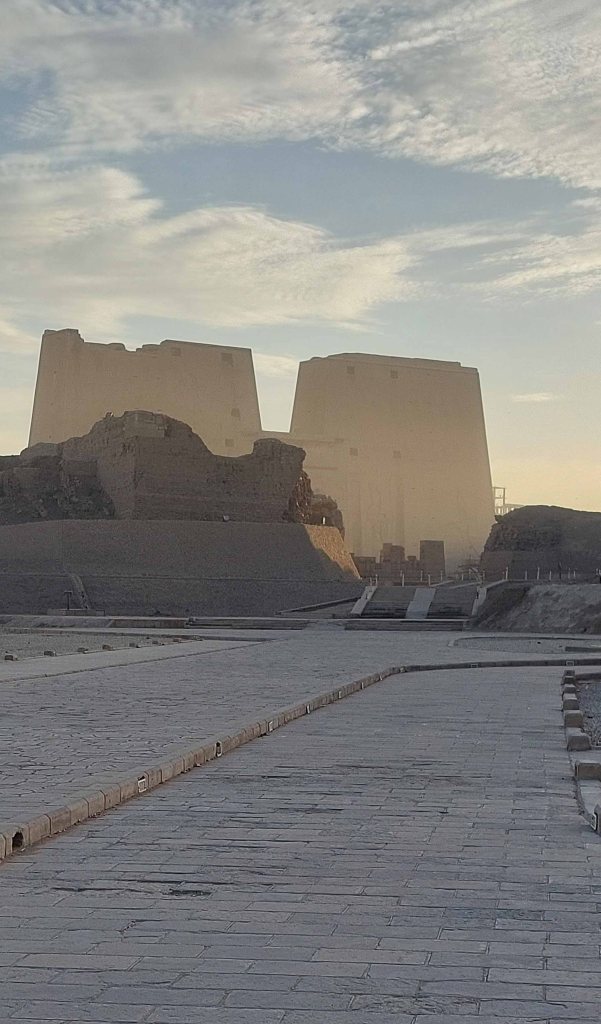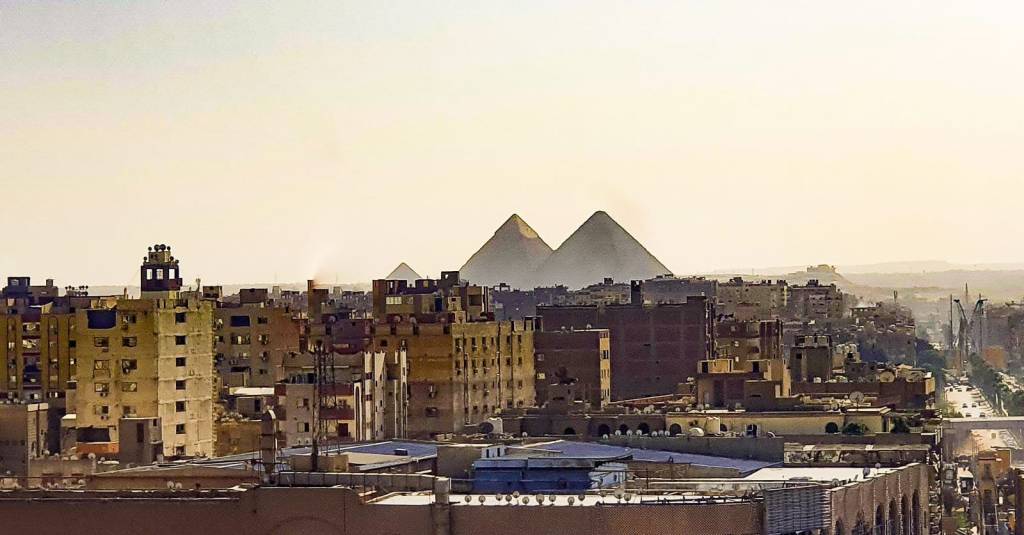Our Nile ship docked for the night at Edfu. The famous temple is about a kilometer from the dock, and can get very crowded. So Ahmed, our best-in-Egypt tour guide, arranged that we would arrive before opening. We took prearranged taxis and showed up first, well before dawn. Completely worth it!
As other groups followed, many guides warmly greeted Ahmed, and told us how lucky we were to have him!
Once the doors opened, we trotted as fast as our legs could carry us to the temple.


The day dawned blue and bright. We got some very good images – clear – and thankfully right then, because it wasn’t long before smoke from neighborhood cooking fires obscured the sky. For maybe 20 minutes we had Edfu pretty much to ourselves. Edfu, constructed over 180 years starting in 237 BCE, is so well preserved because it was completely filled in and covered with sand until its rediscovery in the 1860s by French archeologist Auguste Mariette. For two thousand years before construction this real estate was already a holy site for Horus worship.

The falcon God Horus, to which this temple is dedicated, is the God of the sky, healing, kingship, and protection. Horus is a part of the most famous of all ancient Egyptian stories, and his symbolism is with us today, in the symbol for a prescription medication, Rx. Rx is a derivative of the hieroglyphic for the eye of Horus. Essentially, this is the story of the marriage, betrayal, conspiracies, incest, sexual intimidation, love, murder, reincarnation, and more, amongst the gods and goddesses Osiris, Isis, Set, Horus, and Nephthys.
Part of this important story is that the God of violence and chaos, Set, and Horus had a fight. Horus lost eyes. His mother Isis, Goddess of motherhood and healing, searched with Nephthys, her sister, for the the eyes and found them. Isis healed Horus’ eyes, and ever since the eye has been a sign of healing. Ancient Egyptians believed this battle happened exactly where the Temple at Edfu was constructed. All sorts of unmentionable acts occurred in this lengthy story.
More on this complex, completely bizarre, and important story later.
Our O-Dark Hundred arrival had its benefits.


I couldn’t resist acting like a Pharaoah smiting down my foe. The many walls were worth up close examination. For a fleeting time, we could explore on our own. But it wasn’t long before 1,000s of tourists turned up.
This temple astounded me in that it is a temple within a temple within a temple. Each “layer” is completely covered with exquisitely carved scenes. The work undertaken is unimaginable. There are many scenes of the barge carrying Horus on his journeys.



And in the center temple ‘layer,’ is the Horus barge itself.




Horus was married to Hathor. Hathor was the goddess of dance, joy, love, sexuality, and music. Her dedicated temple was at Dendera. Twice a year, ancient Egyptians engaged in festivals dedicated to this couple. A statue of Hathor would travel 106 miles up the Nile from Dendera to meet Horus at Edfu. This meeting kicked off a terrific celebration.
The Story of Osiris, Isis, Set, Nephthys and Horus
This R-rated story was fundamental to Egyptian mythology, symbolism and their lifestyle. It lays out the landscape of various ultra-important things to Egyptians, such as who rules the afterlife.
Who is Who
Osiris – Osiris, ruler of Egypt and descendant of the origin Gods, is god of agriculture, fertility, and the underworld. His role in the underworld is not a devil. He manages souls crossing the underworld to the next life. It Osiris who decides if a soul is worthy of crossing into the afterlife. Osiris is married to Isis.
Set – God of violence and chaos. Set is brother to Osiris – and a rival.
Isis – Goddess of magic, motherhood and healing. Wife of Osiris.
Horus – God of the sky, kingship, healing, protection. Son of Osiris and Isis.
Nephthys – Goddess of mourning, protector of mummies, protection, the dead, and, oddly, beer. Sister of Isis. Wife of Set.
Ma’at – Goddess of balance, harmony, order, law, morality, truth, and seasonal and cosmic rhythms. Ma’at was also a set of 42 principles by which Egyptians lived their lives.
Got all that? Time to grab a beer or a glass of wine, because this is quite a story. Many twists and turns. Put the kids in another room. This story is said to be dated to at least 2,400 BCE. It was recounted by the Greeks and the Romans. I will say this! To come up with this kind of stuff, they must have had time on their hands. And lots of ancient Egyptian beer. So, without further adieu…
Set is jealous of Osiris, the highest god. He wants to get rid of him and take his throne. Some versions say Set was furious with Osiris for having sex with Set’s wife Nephthys. So, he hatches a plan. He has a party, invites many of his friends and relatives. He builds a lockable box in the exact dimensions of Osiris. Once the party turns lively, he brings out the box and challenges everyone to see if they can fit inside. Everyone tries and nobody fits, but the last to try is Osiris, and he fits exactly – so tightly that the only way he can fit is by crossing his arms. Once inside, Set locks the box! With Osiris inside, Set manages to throw the box into the Nile, and it drifts away. Osiris drowns. And ever since, Egyptians had themselves put into sarcophaguses with their arms crossed, because this was the right way to the underworld. Set takes the throne.
With Set “in charge,” the morality, balance and peace of Maat is upended. Chaos ensues. Civil unrest erupts. The Nile floods at the wrong times. Celestial movements are off kilter. The once predictable seasons are off. Egyptians steal from and lie to each other.
Osiris is terribly grieved and recruits sister Nephthys in a search to find the body of Osiris. Legend has it that they turned into falcons, scanned everywhere, and found it (in parts) many miles upriver. They mummified him and set about various incantations to bring him back to life. He does come back. And Isis has sex with the resurrected Osiris, becoming pregnant with Horus. Osiris, however, isn’t interested in the living world anymore, and decides to become ruler of the underworld.
Pregnant Isis knows her progeny would be a threat to Set. So she hides herself in a marshy area on the Nile full of papyrus. There, after months, she gives birth to Horus. The early life of Horus was full of challenges, some versions say poison by snakebites. Isis is said to travel amongst ordinary humans in search of treatments. Many of these turned into magical spells.
As an adult, Horus challenges Set for the throne. An 80-year long, often violent, contest ensues. In most conflicts Horus wins. But the “judges,” other gods, often are favored of Set. Then the conflict turns sexual. Set wants to have sex with Osiris, who agrees if Set gives him some power. Central to this story is that Egyptians thought semen was poisonous. Set’s semen enters Horus’ body and makes him sick. OK that’s one story! Get ready for the alternative version. In this story, Horus prevents by catching Set’s semen in his hands. Then, and don’t ask me details, because I can’t find any. But Isis puts Horus’ semen on a lettuce leaf, which Set eats and becomes poisoned and pregnant instead. In more sexual violence, Set removes the eye of Horus and a testicle!
Well, Isis the healer once again comes to rescue and puts everything back together. With Horus restored, Set is finally defeated, Horus becomes ruler of Egypt, and all the gods and goddesses celebrate.
With Horus on the throne, Maat is restored. The moon returns to full brightness. Egyptians live peacefully. Seasons once again become dependable. The stars and constellations are once again recognizable.
So. I said it before and I’ll say it now! To me, this just proves how productive Egyptian agriculture had become. They had so much bounty that they were able to “hang out,” think about things, drink beer, and make up the most crazy stories ever told!











